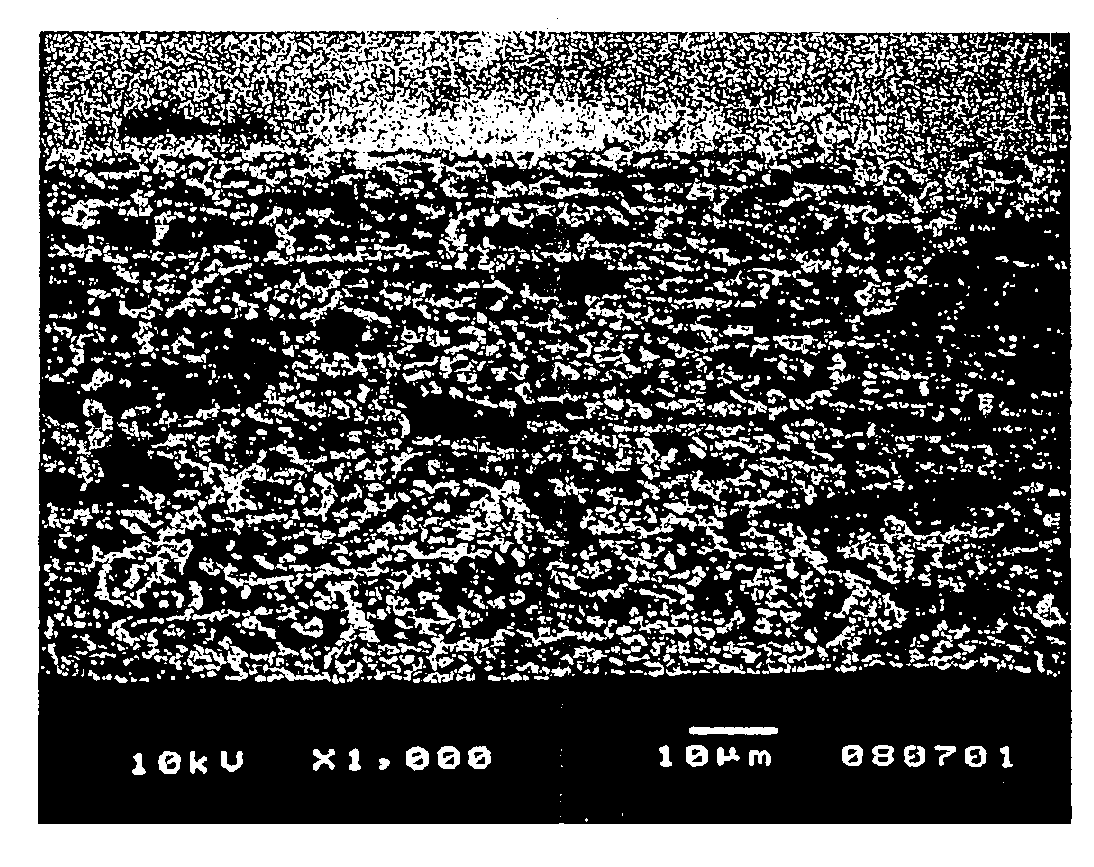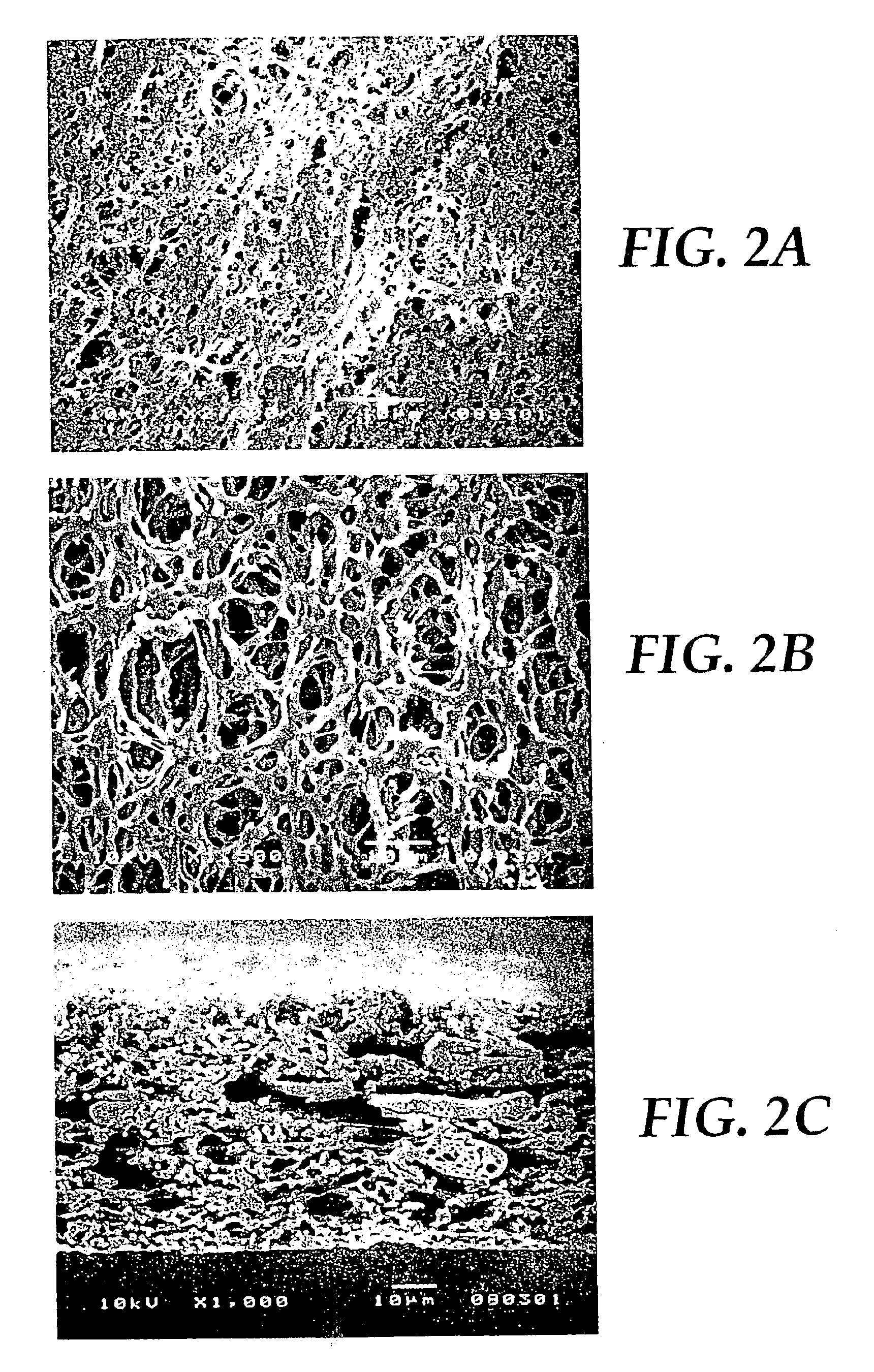Hydrophobic membrane materials for filter venting applications
- Summary
- Abstract
- Description
- Claims
- Application Information
AI Technical Summary
Problems solved by technology
Method used
Image
Examples
example 1
[0082]A casting solution was prepared containing 15 wt. % Dyneon™ THV 220A, 5 wt. % n-butanol (Crown Chemical of San Diego, Calif.) and 80 wt. % DMF (E. I. du Pont de Nemours and Company of Wilmington, Del.) as the solvents. The Dyneon™ THV 220A was added to the solvents and the mixture was heated to about 50 to 60° C. with mixing. A membrane was cast onto a moving belt of polyethylene coated paper using a casting knife with a knife gap of approximately 0.20 mm (approximately 8 mils). The solution was cast at room temperature. The membrane was exposed to air (at room temperature, 60% R.H.) for approximately 1 to 2 seconds before quenching. The membrane was quenched in a water bath having a temperature of about 20° C. for more than 10 minutes.
[0083]After quenching, the membrane was rinsed with deionized water and then air-dried at room temperature for approximately 30 minutes. The membrane was hydrophobic (not wettable by water). The membrane was tested for water penetration pressure...
example 2
[0084]A casting solution was prepared containing 15 wt. % Dyneon™ THV220A and 85 wt. % DMF as the solvent using the method as described in Example 1. The resulting membrane was hydrophobic (not wettable by water). The membrane was tested for water penetration pressure and water flow as described in Example 1. The membrane exhibited a 7000 ml / min water flow rate and a water penetration of 6 psi. FIG. 2a provides a SEM image of the skin side of the membrane, FIG. 2b provides a SEM image of the dull side of the membrane, and FIG. 2c provides a SEM image of the cross-section of the membrane. The membrane was asymmetric (degree of asymmetry of approximately 50:1) and had a mean flow pore size of 3.3 μm.
example 3
[0085]A casting solution was prepared containing 15 wt. % Dyneon™ THV220A, 10% n-butanol, and 75 wt. % DMF as the solvent using the method as described in Example 1. The resulting membrane was hydrophobic (not wettable by water). The membrane was tested for water penetration pressure as described in Example 1. The membrane exhibited a water penetration of 50 psi. FIG. 3a provides a SEM image of the skin side of the membrane, FIG. 3b provides a SEM image of the dull side of the membrane, and FIG. 3c provides a SEM image of the cross-section of the membrane. The membrane was asymmetric (degree of asymmetry of approximately 5:1) and had a mean flow pore size of 0.18 μm.
PUM
| Property | Measurement | Unit |
|---|---|---|
| Temperature | aaaaa | aaaaa |
| Dispersion potential | aaaaa | aaaaa |
| Hydrophobicity | aaaaa | aaaaa |
Abstract
Description
Claims
Application Information
 Login to View More
Login to View More - R&D
- Intellectual Property
- Life Sciences
- Materials
- Tech Scout
- Unparalleled Data Quality
- Higher Quality Content
- 60% Fewer Hallucinations
Browse by: Latest US Patents, China's latest patents, Technical Efficacy Thesaurus, Application Domain, Technology Topic, Popular Technical Reports.
© 2025 PatSnap. All rights reserved.Legal|Privacy policy|Modern Slavery Act Transparency Statement|Sitemap|About US| Contact US: help@patsnap.com



